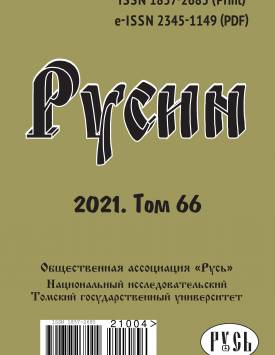Yiddish-Slavic language parallels (on the material of prefixed verbs in Der Nister’s “Shiker” and its Ukrainian translation)
The article analyzes derivational and semantic parallels in Yiddish and Ukrainian from the standpoint of the author's linguistic hybridity theory. It presents the results of a comparative study of prefixed verbs used in the story “Shiker” by the Soviet Yiddish writer Der Nister and its Ukrainian translation “SpyaniLo” (by E. Raitsin). Linguistic parallels are shown as Slavic phenomena in the Yiddish prefixed verb derivation and semantics, resulting from the Slavic adstrate influence on Middle High German - the basis language of Yiddish. The German expression plane of the studied Yiddish prefixes and their genetically Slavic or both German and Slavic content plane are discussed in terms of comparative history. The comparative studies shows that more than half of the verbs in the Yiddish source text contain semantically Slavic homonymous prefixes and German-Siavic hybrid poLysemous prefixes. In terms of transLatoLogy, it is shown that the absolute majority of these verbs are translatable into Ukrainian by simple morphemic and alternative morphemic substitution. In the general theoretical aspect, the terms and concepts “homonymous prefixes” and “hybrid poLysemous prefix” are specified. It has been proved that the Yiddish-SLavic parallels between Yiddish source and Ukrainian target Language / between Yiddish original and its Ukrainian translation are an additional evidence of the German-SLavic hybridity of Yiddish as a genealogically Germanic language.
Keywords
Yiddish,
Ukrainian,
Language hybridity,
Language paraLLeL,
homonymous prefixes,
hybrid poLysemous prefix,
translation,
simple morphemic substitution,
simple alternative morphemic substitutionAuthors
| Shishigin Kirill A. | Plekhanov Russian University of Economics | schischigin-ka@rambler.ru |
| Lebedeva Natalia B. | Kemerovo State University | nlebedevab@yandex.ru |
Всего: 2
References
Бадер О.В. Словообразовательные, морфосинтаксические и стилистические характеристики глаголов с префиксом der- в языке идиш // Филологические науки. Вопросы теории и практики. 2014. № 7 (37), ч. II. C. 33-37.
Виноградов В.В. Избранные труды. Лексикология и лексикография. М.: Наука, 1977. 313 с.
Дер Нистер // Краткая еврейская энциклопедия. Т. 2 / Гл. ред. И. Орен (Надель), М. Занд. Иерусалим: Общество по исследованию еврейских общин, 1982. Кол. 331-334.
Добровольский Д.О. Беседы о немецком слове. М.: Языки славянской культуры, 2013. 744 с.
Дубичинский В.В., Ройтер Т. Теория и лексикографическое описание лексических параллелей. Харьков: Підручник НТУ «ХПІ», 2015. 148 с.
Дымшиц В. «Семья Машбер»: трудности перевода. URL: http://narodknigi.ru/journals/85/semya_mashber_trudnosti_perevoda/?sphrase_id=2421 (дата обращения: 23.10.2021).
Загнітко А.П. Теоретична граматика української мови. Морфологія. Донецьк: ДонДУ, 1996. 437 с.
Латышев Л.К., Семёнов А.Л. Перевод: теория, практика и методика преподавания. М.: Академия, 2005. 192 с.
Райгоша В.П. Проблемы перевода с близкородственных языков. Белорусско-русско-украинский поэтический взаимоперевод. Минск: БГУ им. В.И. Ленина, 1980. 184 с.
Українсько-російський словник / Ред. Л.С. Паламарчук, Л.Г. Скрипник. Київ: Головна редакція Української Радянської Енциклопедії, 1986. 940 с.
Федченко В.В. Развитие видо-временной семантики у маркеров пассивного залога в идише // Вопросы языкознания. 2016. № 1. С. 94-113.
Шишигин К.А. Гибридизация языков: глагольно-префиксальная система идиша / Науч. ред. Н.Б. Лебедева. М.: Флинта; Наука, 2016. 208 с.
Шишигин К.А. Славянский адстрат в гибридной глагольно-префиксальной системе идиша // Русин. 2016. № 3 (45). С. 129-145. DOI 10.17223/18572685/45/10
Шишигин К.А., Лебедева Н.Б. Славянские языки как фактор гибридизации идиша // Русин. 2015. № 3 (41). С. 210-225. DOI 10.17223/18572685/41/15
Beider A. Yiddish in Eastern Europe // Languages in Jewish Communities, Past and Present / ed. by B. Hary, S.B. Benor. Berlin; Boston: Walter De Gruyter, 2018. P. 276-312.
Birnbaum S. A. Yiddish: A survey and a grammar. Toronto; Buffalo: University of Toronto Press, 1979. 399 p.
Brückner A. Słownik etymologiczny jęnzyka polskiego. Warszawa: Wiedza Powszechna, 1985. 822 s.
Duden. Herkunftswörterbuch. Etymologie der deutschen Sprache. Mannheim u.a.: Dudenverlag, 2001. 960 s.
Estraikh G. Soviet Yiddish. Language planning and linguistic development. Oxford: Clarendon Press, 1999. 217 p.
Gоłąb Z. The conception of “isogrammatism” // Biuletyn polskiego towarzystwa językoznawczego. 1956. Z. XV. S. 3-12.
Jakobson R. Preface to the first edition (1949) // Weinreich U. College Yiddish: An introduction to the Yiddish language and to the life and culture. New York: YIVO Institute for Jewish Research, 1995. P. 9-10.
Krogh S. Das Ostjiddische im Sprachkontakt: Deutsch im Spannungsfeld zwischen Semitisch und Slavisch. Tübingen: Max Niemeyer, 2001. 78 s.
Landau A. Di slavishe elementn un hashpoes in yidish // Shriftn fun yidishn visnshaftlekhn institut. Filologishe shriftn. 1928. Num. 2. Z. 199-214.
Lexer M. Mittelhochdeutsches Wörterbuch. Stuttgart: Hirzel, 1992. 516 s.
Ludwig J. Z. Multiply-Prefixed Verbs in Russian, Polish, and Ukrainian: Doctoral dissertation. Bloomington: Indiana University, 1995. 210 p.
Mark Y. Gramatik fun der yidisher klal-shprakh. New York: Alveltlekher yidisher kultur-kongres, 1978. 407 z.
Miklosich F. Etymologisches Wörterbuch der slavischen Sprachen. Wien: Wilhelm Braumüller, 1886. 555 s.
Podręczny słownik polsko-rosyjski z suplementem / Pod red. M.F. Rozwadowskiej. Warszawa: Wiedza Powszechna, 1974. 856 s.
Rothstein R.A. Yiddish Aspectology // Studies in Yiddish Linguistics / Ed. by P. Wexler. Tübingen: Max Niemeyer Verlag, 1990. S. 143-153.
Schächter M. Aktionen im Jiddischen: Dissertation zur Erlangung des Doktorgrades. Wien: Universität Wien, 1951. 29 s.
Talmy L. Borrowing semantic space: Yiddish verb prefixes between Germanic and Slavic // Proceedings of the Eighth Annual Meeting of the Berkeley Linguistics Society / eds. by M. Macaulay, et al. Berkeley, 1982. P. 231-250.
Timm E. Historische jiddische Semantik: Die Bibelübersetzungssprache als Faktor der Auseinanderentwicklung des jiddischen und des deutschen Wortschatzes. Tübingen: Max Niemeyer, 2005. 744 s.
Vaynraykh M. Vos volt yidish geven on hebreish? // Di tsukunft. 1931. Num. 36.3. Z. 194-205.
Vaynraykh M. Geshikhte fun der yidisher shprakh: bagrifn, faktn, metodn. New York: YIVO, 1973. Bd. I. 370 z.
Weinreich M. Geschichte der jiddischen Sprachforschung. Tampa: University of South Florida, 1993. 351 s.
Weinreich U. Modern English-Yiddish, Yiddish-English Dictionary. New York: YIVO; Shoken, 1977. 833 p.
Weissberg J.D. Der Aspekt in abgeleiteten jiddischen Verben. Dargestellt anhand der korrelierenden Konverben iber- und ariber-. Eine kontrastive jiddisch-deutsch-slawische Darstellung // Zeitschrift für Dialektologie und Linguistik. 1991. Jg. 58. S. 175-195.
Wexler P.N. Slavic contributions to the grammatical functions of three Yiddish verbal prefixes: Thesis for the degree of Master of Arts. New York: Columbia University, 1951. 55 p.

